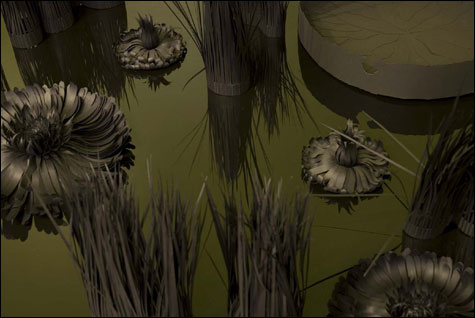
LILY POND: A dark illusion by Lauren Fensterstock. |
| “Parterre: An Installation by Lauren Fensterstock” at Bowdoin College Museum of Art, Brunswick | through January 11, 2009 | 207.725.3275 |
A parterre is a level formal garden, usually laid out with gravel paths between orderly plantings or pools bordered by stone walls or hedges. The historical high point of parterre gardens was Versailles, Louis XIV’s monument to the unrestrained power of the state blended with aristocratic decadence and ostentatious consumption.
The centerpiece of Lauren Fensterstock’s installation at the Bowdoin College Museum of Art is what appears to be a large black pool with giant lily pads, blossoms, and piles of black dust. It’s large, eight by twenty feet, with six-inch-high walls. It’s not water, but Plexiglas and charcoal, and the flowers and plants are made from black paper. The illusion is persistent; it’s difficult to see it as anything but a dark pool with black vegetation, like a formal garden in a quiet corner of Dante’s ninth circle.
The constructions “floating” in the pool are taken from lithographic images of the giant Victoria Regia water lily made by the 19th-century botanical illustrator William Sharp, in Bowdoin’s collection. This plant has giant leaves and excessive flowers, and is sometimes used in formal gardens. The Sharp images are presented in the same gallery, as a reference.
There’s a sparkling horizontal line across the walls of the whole gallery at about eye level. Close up it resolves into a series of tiny jewels set directly into the wall’s surface, a few inches apart. This line joins a large pattern of jewels across the back wall that slowly reveals itself to be a map of the maze in the gardens at Versailles. Etchings by Israel Sylvestre of the gardens at Cardinal Richelieu’s Chateau Rueil, an inspiration for Versailles, are presented nearby, and provide a historical and thematic anchor for the wall-sized schematic.
A vitrine nearby holds a few key objects. Fensterstock sets precious stones into fruits and vegetables and lets them age. Here a shriveled, bejeweled banana and dried potato share the space with a pendant miniature painting and some 18th-century watches that were, when they were made, accessories for only the very well off. Luxury objects are matched with decay; jewels are set in garbage.
One enters, here, a shadow world, where the normal order of things is seen as through a glass darkly. Everything points to elegance, refinement, style, and even luxury. What seems to be an appreciation takes on, after a time, a feeling of quiet decay, as if we are encountering the spiritual accounting for the costs of life lived at great expense.
The late Ed Keinholz, one of the earliest installation artists, made works of social commentary that were like being hit on the head. They were ugly enough to gag a goat. Fensterstock’s work at Bowdoin is, by contrast, more like an innocent invitation to peruse the good life of jewelry, formal gardens, colorful lithographs for collectors, and the accouterments of the luxe life. The implications drift in slowly over time, and are all the more pointed for their misdirection.
Here we are met with formal elegance, with careful, almost obsessive craftsmanship, and clear thematic lines. Yet a profound unease unobtrusively takes root while at the show and grows after leaving the gallery. The fascination of Versailles is its apparent ability to change the rules of life — to impose a mental construct on nature that pushes our awareness of “absence, darkness, death — all that is not” firmly aside and insists we can inhabit a world of perfection. Fensterstock’s parterre shares enough of the means and methods of such places to lull us into that same illusion, and yet the bejeweled and rotten banana in the vitrine whispers the truth.
Ken Greenleaf can be reached at ken.greenleaf@gmail.com.